
Zaxxon is a scrolling shooter developed and released by Sega as an arcade video game in 1982. The player pilots a ship through heavily defended space fortresses. Japanese electronics company Ikegami Tsushinki was also involved in the game's development.

Centipede is a 1981 fixed shooter arcade video game developed and published by Atari, Inc. Designed by Dona Bailey and Ed Logg, it was one of the most commercially successful games from the golden age of arcade video games and one of the first with a significant female player base. The primary objective is to shoot all the segments of a centipede that winds down the playing field. An arcade sequel, Millipede, followed in 1982.

Miner 2049er is a platform game developed for Atari 8-bit computers by Bill Hogue and released by his company, Big Five Software, in 1982. The player controls Bounty Bob through multiple levels of a mine, with the goal of traversing all of the platforms while avoiding or defeating enemy mutants. At a time when "climbing games" such as Donkey Kong had four screens, Miner 2049er had ten.
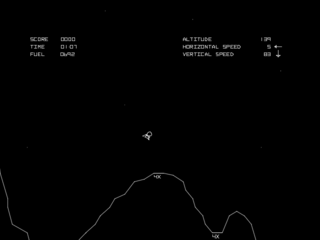
Lunar Lander is a genre of video games loosely based on the 1969 landing of the Apollo Lunar Module on the Moon. In Lunar Lander games, players control a spacecraft as it falls toward the surface of the Moon or other astronomical body, using thrusters to slow the ship's descent and control its horizontal motion to reach a safe landing area. Crashing into obstacles, hitting the surface at too high a velocity, or running out of fuel all result in failure. In some games in the genre, the ship's orientation must be adjusted as well as its horizontal and vertical velocities.

Moon Patrol is a 1982 arcade video game developed and released by Irem. It was licensed to Williams for distribution in North America. The player controls a Moon buggy which can jump over and shoot obstacles on a horizontally scrolling landscape as well as shoot aerial attackers. Designed by Takashi Nishiyama, Moon Patrol is often credited with the introduction of full parallax scrolling in side-scrolling games. Cabinet art for the Williams version was done by Larry Day. Most of the home ports were from Atari, Inc., sometimes under the Atarisoft label.

Shamus is a shooter with light action-adventure game elements written by Cathryn Mataga and published by Synapse Software. The original Atari 8-bit computer version was released on disk and tape in 1982. According to Synapse co-founder Ihor Wolosenko, Shamus made the company famous by giving it a reputation for quality. "Funeral March of a Marionette", the theme song from Alfred Hitchcock Presents, plays on the title screen.
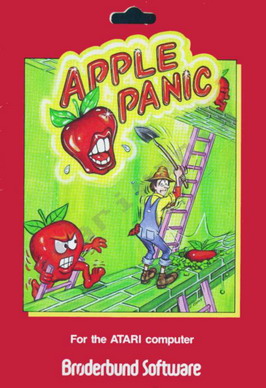
Apple Panic is a game for the Apple II programmed by Ben Serki and published by Broderbund Software in 1981. Apple Panic is an unauthorized version of the 1980 arcade game Space Panic, the first game with ladders and platforms. While the arcade original remained obscure, Apple Panic became a top seller for home computers. It was ported to the Atari 8-bit computers, VIC-20, IBM PC, and TRS-80.

Time Bandit is a maze shoot 'em up written for the TRS-80 Model I by Bill Dunlevy and Harry Lafnear and published by MichTron in 1983. It was ported to the TRS-80 Color Computer and Dragon 32, but enjoyed its greatest popularity several years later as an early release for the Atari ST. It was also released for the pseudo-PC-compatible Sanyo MBC-55x with 8-color display. Amiga and MS-DOS versions were ported by Timothy Purves.

Telengard is a 1982 role-playing dungeon crawler video game developed by Daniel Lawrence and published by Avalon Hill. The player explores a dungeon, fights monsters with magic, and avoids traps in real-time without any set mission other than surviving. Lawrence first wrote the game as DND, a 1976 version of Dungeons & Dragons for the DECsystem-10 mainframe computer. He continued to develop DND at Purdue University as a hobby, rewrote the game for the Commodore PET 2001 after 1978, and ported it to Apple II+, TRS-80, and Atari 800 platforms before Avalon Hill found the game at a convention and licensed it for distribution. Its Commodore 64 release was the most popular. Reviewers noted Telengard's similarity to Dungeons and Dragons. RPG historian Shannon Appelcline noted the game as one of the first professionally produced computer role-playing games, and Gamasutra's Barton considered Telengard consequential in what he deemed "The Silver Age" of computer role-playing games preceding the golden age of the late 1980s. Some of the game's dungeon features, such as altars, fountains, teleportation cubes, and thrones, were adopted by later games such as Tunnels of Doom (1982).
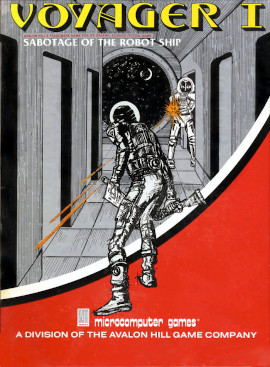
Voyager I: Sabotage of the Robot Ship is a computer game designed and programmed by William D. Volk, and published by the Microcomputer Games division of Avalon Hill. It was originally released for the Apple II in 1981, with later versions for the Atari 8-bit computers, TRS-80 Color Computer, TRS-80, and Commodore PET.

Lunar Lander is a 1980 video game published by Adventure International.

Protector II is a video game written by Mike Potter for Atari 8-bit computers and published by Synapse Software in 1982. It is a sequel to 1981's Protector; both games are horizontally scrolling shooters inspired by the arcade video game Defender. Protector II was ported to the Commodore 64, TI-99/4A, and TRS-80 Color Computer.

Mad Mines is a fixed shooter video game written for the TRS-80 by Yves Lempereur and published by Funsoft in 1982.
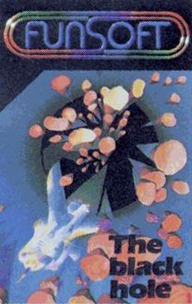
The Black Hole is a 1982 video game published by Funsoft.

Bable Terror is a maze video game for the TRS-80 written by Yves Lempereur and published by Funsoft in 1982.

Demon Seed is a fixed shooter written by Jeffrey Sorensen and Philip MacKenzie for the TRS-80 and published in 1982 by Trend Software. The same programmers developed the TRS-80 Color Computer version published in 1983 by Computer Shack. Demon Seed is a clone of the 1980 arcade game Phoenix.

Jovian is a 1982 video game published by Computer Shack.
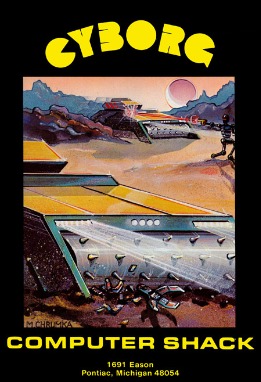
Cyborg is a 1982 video game published by Computer Shack.

Kid Grid is a grid capture game which borrows heavily from the 1981 arcade video game Amidar. Written by Arti Haroutunian for Atari 8-bit computers, it was published by Tronix in 1982. A Commodore 64 port from the same programmer was released in 1983. In Kid Grid, the player moves along the horizontal and vertical lines of the playfield, turning the lines from dotted gray to solid blue. If all the lines around a square are completed, it is filled-in. Deadly creatures chase the player.



















